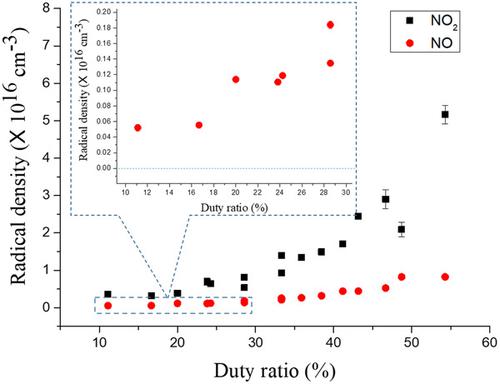当前位置:
X-MOL 学术
›
Plasma Processes Polym.
›
论文详情
Our official English website, www.x-mol.net, welcomes your feedback! (Note: you will need to create a separate account there.)
Measurement of nitrogen dioxide and nitric oxide densities by using CEAS (cavity‐enhanced absorption spectroscopy) in nonthermal atmospheric pressure air plasma
Plasma Processes and Polymers ( IF 3.5 ) Pub Date : 2020-10-22 , DOI: 10.1002/ppap.202000168 Young J. Hong 1 , Junsup Lim 1 , Jin S. Choi 1 , Klaus D. Weltmann 2 , Eun H. Choi 1
Plasma Processes and Polymers ( IF 3.5 ) Pub Date : 2020-10-22 , DOI: 10.1002/ppap.202000168 Young J. Hong 1 , Junsup Lim 1 , Jin S. Choi 1 , Klaus D. Weltmann 2 , Eun H. Choi 1
Affiliation

|
Nonthermal atmospheric pressure plasmas are widely used in biomedicine and agriculture. Currently, radical density is used as an important parameter for the development of plasma biomedicine and agriculture. Especially, nitrogen dioxide (NO2) and nitric oxide (NO) radicals are significant species in these applications. These could be measured by using the cavity‐enhanced absorption spectroscopy (CEAS) technique. For the NO2 and NO radical density measurement, we used a visible LED (light‐emitting diode) of 660 nm and a mid‐infrared LD (laser diode) of 5238.6 nm, respectively. Radical densities can be calculated with the transmission ratio using Beer–Lambert law, which is obtained by the absorbed amount of laser intensity passed through the gas from the plasma jet in an optical cavity of CEAS.
中文翻译:

在非热大气压空气等离子体中使用CEAS(腔增强吸收光谱法)测量二氧化氮和一氧化氮的密度
非热大气压等离子体广泛用于生物医学和农业。目前,自由基密度被用作血浆生物医学和农业发展的重要参数。特别地,在这些应用中,二氧化氮(NO 2)和一氧化氮(NO)自由基是重要的物质。这些可以通过使用腔增强吸收光谱(CEAS)技术进行测量。对于NO 2和NO自由基密度测量,我们分别使用了660 nm的可见LED(发光二极管)和5238.6 nm的中红外LD(激光二极管)。辐射密度可以使用比尔-兰伯特定律通过透射比来计算,该比是通过在CEAS光学腔中从等离子流通过气体的激光强度的吸收量得出的。
更新日期:2020-10-22
中文翻译:

在非热大气压空气等离子体中使用CEAS(腔增强吸收光谱法)测量二氧化氮和一氧化氮的密度
非热大气压等离子体广泛用于生物医学和农业。目前,自由基密度被用作血浆生物医学和农业发展的重要参数。特别地,在这些应用中,二氧化氮(NO 2)和一氧化氮(NO)自由基是重要的物质。这些可以通过使用腔增强吸收光谱(CEAS)技术进行测量。对于NO 2和NO自由基密度测量,我们分别使用了660 nm的可见LED(发光二极管)和5238.6 nm的中红外LD(激光二极管)。辐射密度可以使用比尔-兰伯特定律通过透射比来计算,该比是通过在CEAS光学腔中从等离子流通过气体的激光强度的吸收量得出的。



























 京公网安备 11010802027423号
京公网安备 11010802027423号